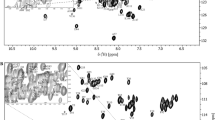Abstract
The regulation of nitric oxide synthase (NOS) by calmodulin (CaM) plays a major role in a number of key physiological and pathological processes. A detailed molecular level picture of how this regulation is achieved is critical for drug development and for our understanding of protein regulation in general. CaM is a small acidic calcium binding protein and is required to fully activate NOS. The exact mechanism of how CaM activates NOS is not fully understood at this time. Studies have shown CaM to act like a switch that causes a conformational change in NOS to allow for the electron transfer between the reductase and oxygenase domains through a process that is thought to be highly dynamic. The interaction of CaM with NOS is modified by a number of post-translation modifications including phosphorylation. Here we present backbone and sidechain 1H, 15N NMR assignments of modified CaM interacting with NOS peptides which provides the basis for a detailed study of CaM–NOS interaction dynamics using 15N relaxation methods.


Similar content being viewed by others
References
Alderton W, Cooper C, Knowles R (2001) Nitric oxide synthases: structure, function and inhibition. Biochem J 357:593–615
Corti C, L’Hostis E, Quadroni M, Schmid H, Durussel I, Cox J, Hatt P, James P, Carafoli E (1999) Tyrosine phosphorylation modulates the interaction of calmodulin with its target proteins. Eur J Biochem 262:790–802
Daff S (2010) NO synthase: structures and mechanisms. Nitric Oxide 23:1–11
Ikura M, Ames J (2006) Genetic polymorphism and protein conformational plasticity in the calmodulin superfamily: two ways to promote multifunctionality. Proc Natl Acad Sci USA 103:1159–1164
Jang D, Guo M, Wang D (2007) Proteomic and biochemical studies of calcium- and phosphorylation-dependent calmodulin complexes in mammalian cells. J Proteome Res 6:3718–3728
Keller R (2005) Optimizing the process of nuclear magnetic resonance spectrum analysis and computer aided resonance assignment. Dissertation, Swiss Federal Institute of Technology, Zurich
Mishra O, Ashraf Q, Delivoria-Papadopoulos M (2009) Tyrosine phosphorylation of neuronal nitric oxide synthase (nNOS) during hypoxia in the cerebral cortex of newborn piglets: the role of nitric oxide. Neurosci Lett 462:64–67
Persechini A, Kretsinger R (1988) The central helix of calmodulin functions as a flexible tether. J Biol Chem 263:12175–12178
Su Z, Blazing MA, Fan D, George SE (1995) The calmodulin-nitric oxide synthase interaction. Critical role of the calmodulin latch domain in enzyme activation. J Biol Chem 270:29117–29122
Welland A, Daff S (2010) Conformation-dependent hydride transfer in neuronal nitric oxide synthase reductase domain. FEBS J 277:3833–3843
Author information
Authors and Affiliations
Corresponding author
Rights and permissions
About this article
Cite this article
Piazza, M., Guillemette, J.G. & Dieckmann, T. Chemical shift perturbations induced by residue specific mutations of CaM interacting with NOS peptides. Biomol NMR Assign 9, 299–302 (2015). https://doi.org/10.1007/s12104-015-9596-0
Received:
Accepted:
Published:
Issue Date:
DOI: https://doi.org/10.1007/s12104-015-9596-0




